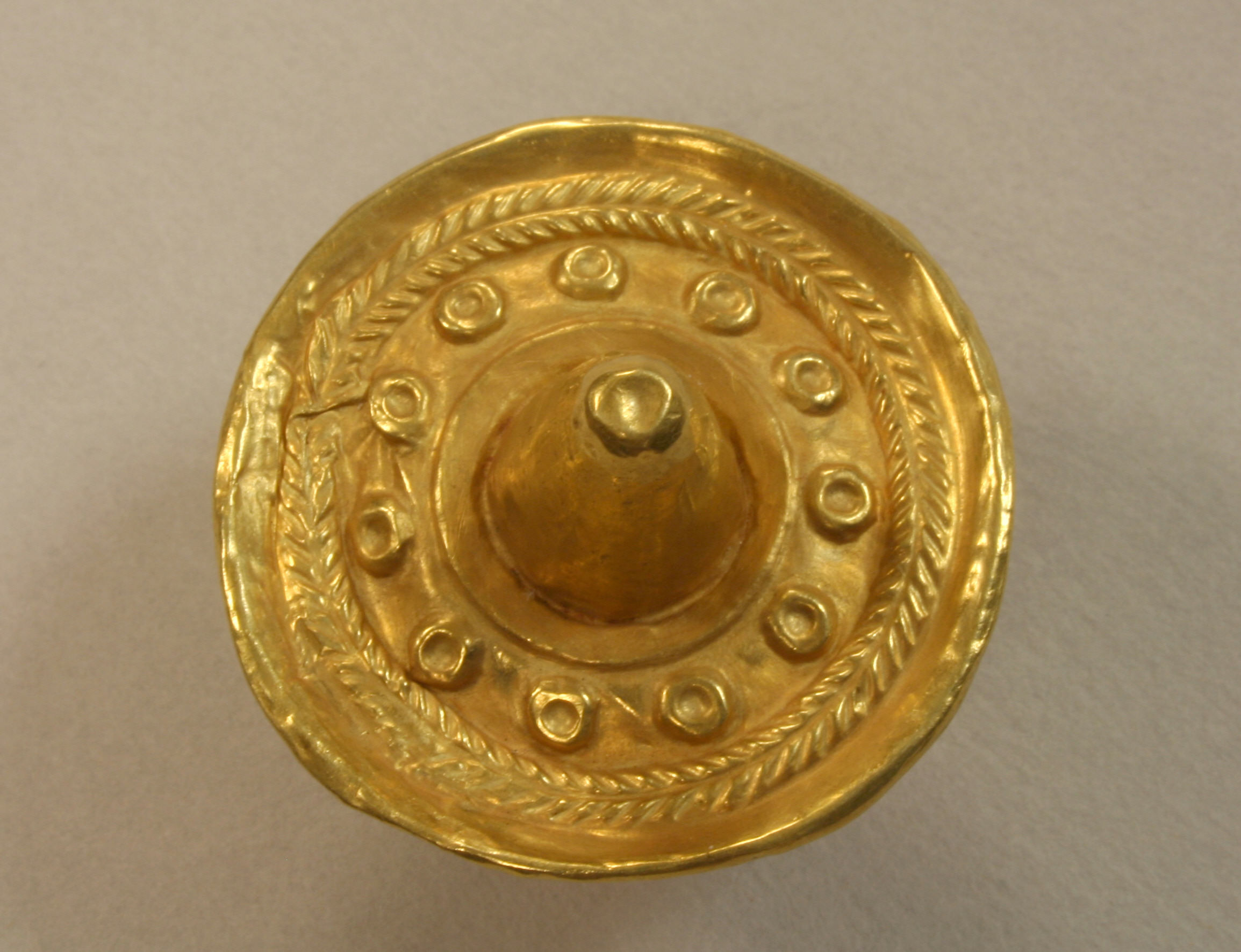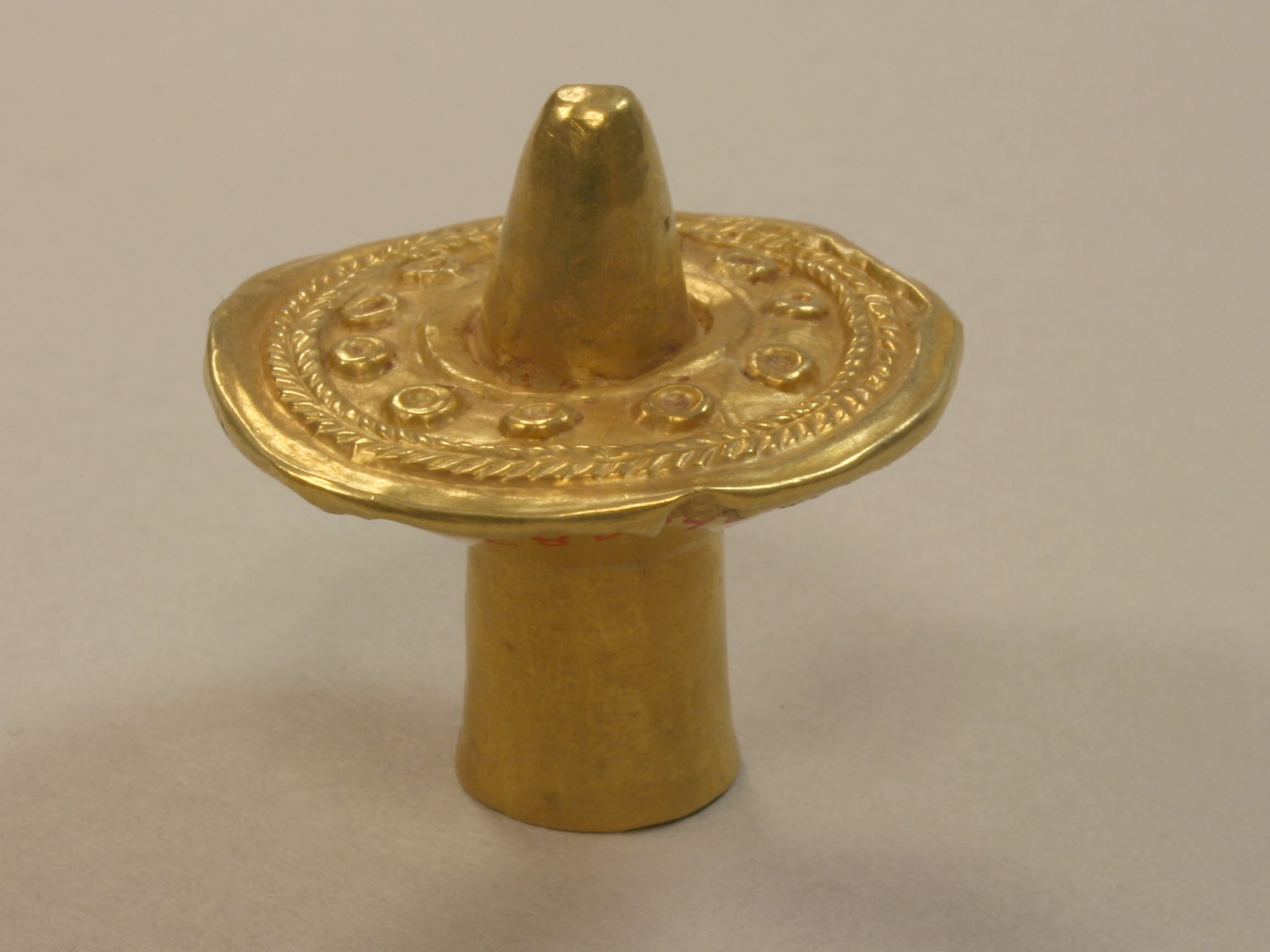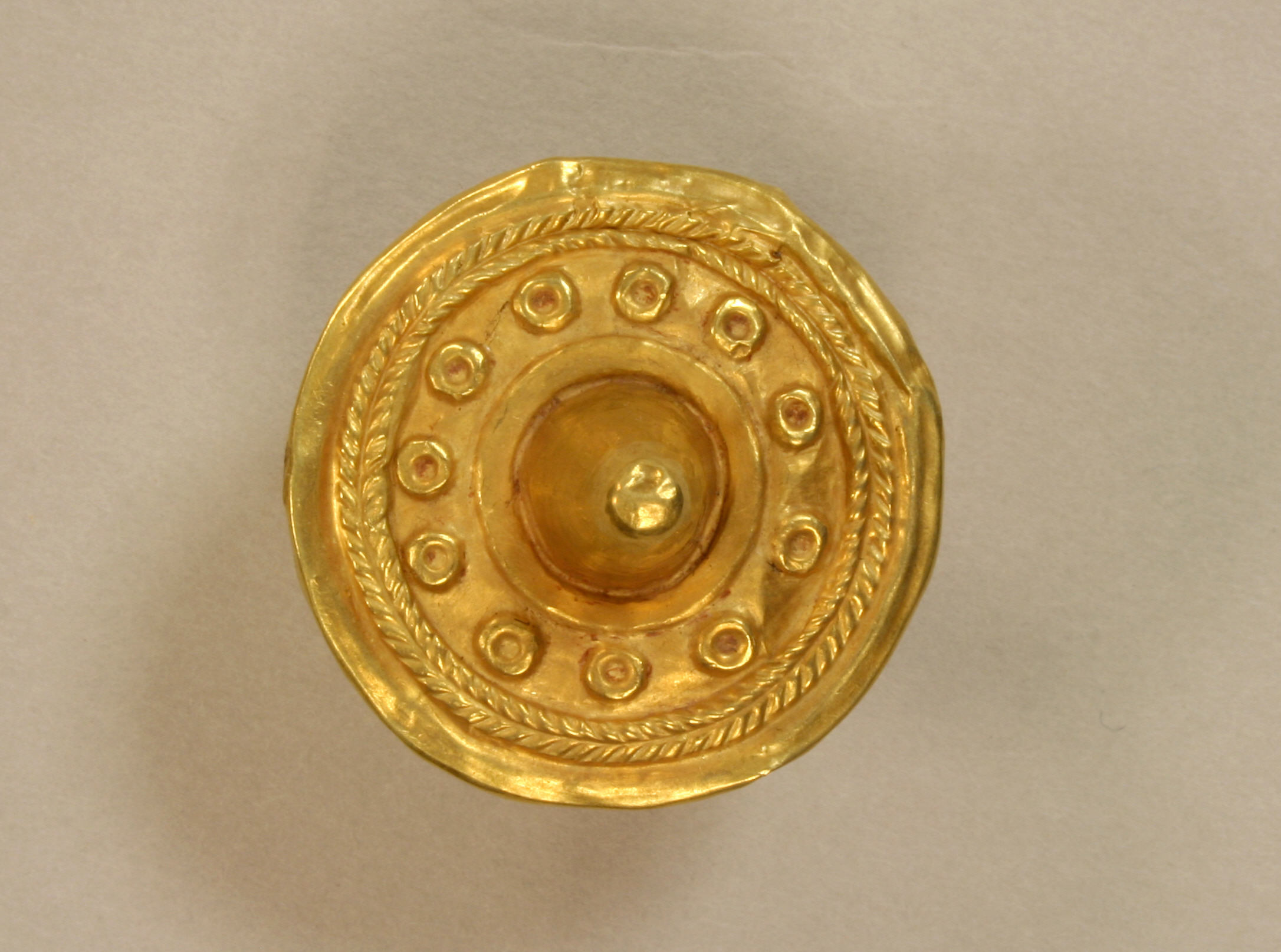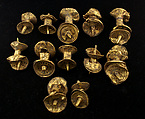Ear Spool
Not on view
This ear spool is made of hammered metal sheet and consists overall of two separate components or “halves,” (here designated “a” and “b”). Each half includes three joined pieces: a center piece with one end cylindrical and the other end conical, a piece with one end cylindrical and the other end flaring out, and a circular and relatively flat piece with geometric motifs. The metalsmith fit the first piece into the second and may have lightly hammered the exterior and interior of the cylindrical end to help secure the join. There does not appear to be any evidence of soldering of the two pieces. The third piece—flat with geometric motifs—was placed over the conical center and its ends were crimped over the second piece to help secure its placement. To wear the ear spool, it is possible that the two halves were separated, the cylindrical ends were passed through the earlobe, and then the two halves were rejoined. Please see below for further discussion. Also, see another work in the Met’s collection, 1979.206.484a, b, which may constitute the other ear spool, similarly consisting of two halves, with which this one would have been paired. This supposes that ear spools of nearly identical designs, such as these two, were paired, one to be worn by a person in each ear. However, contextual information cannot confirm this point.
In the case of both halves, the third piece, with geometric motifs, includes, from the outer edge to the interior, three registers of design: first, a band of chevrons, slightly in raised relief, that wrap around the circumference; then, 11 circular motifs each of which has a slight depression in the center; and finally, a band that is slightly raised, adjacent to the base of the conical projection at the center of the piece. The band of chevrons on each spool is actually comprised of two rows of parallelogram-shaped punch marks that point to each other at a 90-degree angle; these two rows of marks do not touch but are separated by a narrow space. Viewing each half ear spool from below, and looking into the cavity within the cylindrical end, it is possible to see the design on the third piece—some of the circular motifs and some of the raised band—but in reverse. Overall, the geometric designs are consistent between the two ear spool halves. The only marked variation is in the presence of creases in certain areas of the design, an effect of working these designs into the thin sheet.
Each of the three pieces was hammered to its present thinness and then shaped by further hammering and by chiseling at the edges to separate the pieces from their respective larger sheets. On the piece with geometric motifs, the chevron design and the interior band were made by repoussé, hammering from the back of the sheet. The circular motifs between them also were made by repoussé with some chasing, hammering from the front, to give the motifs their central depressions.
This ear spool is part of a corpus of metalwork from the region known as Greater Coclé (Gran Coclé) in central Panama. This region has been defined around a certain series of ceramics that begins with the appearance of Monagrillo style pottery as early as 2500 B.C. (Mayo 2006, 25-26). When this object was first accessioned at the Museum of Indigenous Art (later to become the Museum of Primitive Art (MPA), ultimately part the Metropolitan Museum of Art), the documentation from the dealer, John Wise, referred to the object as “Coclé,” but without further geographic or stylistic specificity (see de Montebello in Jones and King 2002). However, in the MPA accession records, and in an Examination and Treatment Report from 1980 at the Met, in which the ear spool was studied with 1979.206.484a, b, the object was identified as coming from Sitio Conte. In the absence of any reference to Sitio Conte in the documentation from Wise, and a note on the ear spool in the MPA accession records by Lothrop on February 25, 1958 that the object was “typical Sitio Conte style,” it can inferred that the subsequent references to Sitio Conte are to a style, and not necessarily to provenance from the site. Given the recovery of similar ear spools from outside of Sitio Conte, the broader stylistic designation “Greater Coclé” is used here.
Similar ear spools were indeed excavated from Sitio Conte, an archaeological site along the banks of the Río Grande. Consisting primarily of human burials and caches, the site was named after the landowner at the time of its excavation, Miguel Conte. It encompassed approximately 4 to 5 acres and was known to have been flooded by the river during the rainy season (Lothrop 1937). The ceramics from the site are primarily in the Conte (A.D. 700–900) and Macaracas (A.D. 900–1100) styles, including polychrome pottery whose notable features are the incorporation of purple as well as the use of black on the perimeters of designs (Mayo 2006). The time span of the burials at Sitio Conte (ca. A.D. 450–900) includes metalwork in both the Initial and the International Styles (Bray 1992; Cooke et al. 2000). Interpretations of the social organization at Sitio Conte and other sites in the region have tended to rest on Spanish colonial sources, which suggest the presence of chiefdoms in Greater Coclé at the time of Spanish conquest (summarized in Briggs 1989, 143–147). These interpretations reproduce these colonial biases, focusing on the importance of individual adult males and correlating their status with the number and quality of materials with which they were found buried, a correlation for which Briggs (1989, 8–15) finds a basis in the U.S. Army, a key agent of colonization in Panama in the 20th century. Alternatives, fully apart from this colonial framework, are needed for interpreting these social dynamics. One way forward is greater respect for knowledge production by people with long histories in the Central American Isthmus, but whose voices and contributions often have been marginalized in the historical discourse: indigenous peoples, who are native to the land, and Afro-descendant peoples, whose ancestors were forcibly brought from Africa and the Caribbean to labor.
At Sitio Conte, there are several examples of metal ear spools, many of which reveal a similar fabrication technique, while one example in stone has ends that are joined by a peg (Lothrop 1937, figs. 126–128). Some of these ear spools have been documented with provenience, including what appear to be two halves that are part of one ear spool, found separately but near each other and near fragments of a red plate in Grave 24 (Lothrop 1937, fig. 239, objects 107–108). These artifacts were recovered near human remains but not in any direct association to suggest a particular location on the body where the ear spool may have been worn in burial, or that it was worn at all. Another ear spool half was recovered near scattered human remains (part of Skeleton III) in Grave 32 (Lothrop 1937, figs. 251–252, object 29) and two more ear spools, with their halves joined, were found near Skeleton IV, also in Grave 32, but similarly without a direct association with the human remains (Lothrop 1937, figs. 251–252, objects 46–47). Other forms of ear ornaments at Sitio Conte include long hollow tubes of hammered metal sheet recovered on the sides of skulls in Burial 11 along with greenstone rods covered with metal sheet. These metal tubes often have a separate ornate cap, whose basic shape and geometric design are reminiscent of some of the ear spool halves already discussed. In the cases where hollow metal tubes were recovered, investigators have suggested that they enclosed resin or wood that did not preserve (Hearne and Sharer 1992, 116, pls. 52–57).
Other similar ear spools have been recovered from Tomb 6 at El Caño, a funerary and ritual complex that is 2.5 km to the north of Sitio Conte, associated with individual 1 and in a context dated to A.D. 775–790 / 800–980 [calibrated] (Mayo and Mayo 2017) (see Figure 5). These were recovered not directly with human remains but in a packet of materials; at least seven were recovered with the two separate halves joined by fitting one cylindrical end into the slightly wider cylindrical end of the other. This fitting would have been possible with the two halves discussed here; the diameter of the cylindrical end of one is 1.4 cm and that of the other is 1.3 cm. The ear spools from El Caño show a similar fabrication process involving three pieces as well as similar geometric motifs, but instead of circles, often including triangular elements. In some cases, there is a fourth piece associated with these ear spool halves—a flat, cut-out sheet with triangular elements—that would have attached to the piece surrounding the conical center. There are other forms of ear ornaments from El Caño, including tubes of greenstone with covers on their ends made of metal sheet as well as long metal tubes with ornate finials whose motifs recall those of the ear spools described here, typically with a projection at the center.
Ear spools similar to the two halves discussed here are known from collections without provenience, including Dumbarton Oaks (PC.B.548) and the British Museum (no. 1898,312) (see Meeks 1998). In each of these two cases, there are four halves and they display subtle technical differences, especially in the areas of their geometric designs. In the overall corpus of these ear spools, comparing the geometric designs, each “set” of four appears slightly different (one has a design that is more circular than triangular; one has a triangular design where the areas that are chiseled away are distinct from those cut out in another ear spool with a similar design). These ear spools have not, to this author’s knowledge, been recovered in direct association with human remains. This raises the question of their arrangement in deposition, which may differ from how they would have been worn by people. Julia Mayo (personal communication, 2017) has suggested that these ear spools would be difficult to wear without some type of bar passing through the ear and connecting the two halves which would be seen, when worn, on either side of the ear. Perhaps the way of inserting the cylindrical end of one half into the other was a means of storing these ear spools when they were not worn on the human body. Overall, the ear spools made by people in the Greater Coclé region are distinctive in terms of design, particularly that they were composed of metal sheet and their central conical projections. At least two metal ear spool halves, which appear to be a pair, were recovered at La Tolita (ca. 600 B.C.–A.D. 400), in Ecuador (University of Pennsylvania Museum of Archaeology and Anthropology, Philadelphia, PA, SA2854): one cylindrical end fits over the other; however, at least the broader ends appear to have been cast. Other ear spool halves in the Tolita tradition, made of metal, have been found but are made of soldered wire to create a filigree design (Museo del Banco Central, Quito 3803-2-60). The Coclé ear spools are also distinct from ear spools fabricated by metalworkers in the Calima region (in what is now Colombia) during the Yotoco period (100 B.C.–A.D. 800) (e.g., Metropolitan Museum of Art 1991.419.41, 1991.419.42, Museo del Oro, Bogotá O24929 and O24930) that are made of hammered sheet and comprised of multiple pieces, with crimping in certain locations. However, in the case of the Calima ear spools, the flare from one end toward the center extends much farther to the center than that of the Coclé ear spools, and the geometric design is unique, often showing arcs and small points. In short, the practices of making ear spools are distinct in these three regions, with metalworkers drawing on local sources of gold, and likely associating different meanings and values with the ear spool form in each place. The archaeological contexts of this type of Coclé ear spool, found for the most part in human burials but not in direct association with bodies, lead to questions about their role in the ways that people present themselves: were they worn by certain people in daily life? If so, who wore them, and, as ear ornaments, what role did they play in transforming a person’s ability to hear? Considering alternative models of social organization, centering subaltern voices while also de-centering the human to some extent may provide insights, while leading to new understandings of how people value land, water, and minerals.
Bryan Cockrell, Curatorial Fellow, Arts of Africa, Oceania, and the Americas, 2017
Exhibitions
Precolumbian Gold Sculpture, Museum of Primitive Art, Oct. 29, 1958 – Feb. 8, 1959, checklist no. 4; Gold Before Columbus, LA County Museum, March 19 – May 15, 1964, cat. no. 18; Masterpieces from the Americas, Museum of Primitive Art, May 20 – Nov. 11, 1964; The Art of Personal Adornment, Museum of Contemporary Crafts, Sept. 23 – Nov. 7, 1965, cat. no. 325; The World of Primitive Art, Museum of Primitive Art, Jul. 12 – Sept. 11, 1966; Gold of Precolumbian America, Hermitage Museum, Aug. 4 – Oct. 1, 1976, The State Museum of Representational Arts, Oct. 15 – Dec. 15, 1976, The Kiev State Historical Museum, Jan. 5 – March 1, 1977, p. 144, no. 135
Published References
Emmerich, André. 1977. Sweat of the Sun and Tears of the Moon: Gold and Silver in Pre-Columbian Art. New York: Hacker, fig. 120.
Further Reading
Bray, Warwick. “Sitio Conte Metalwork in Its Pan-American Context.” In River of Gold: Precolumbian Treasures from Sitio Conte, edited by Pamela Hearne and Robert J. Sharer, 32-46. Philadelphia: University Museum, University of Pennsylvania, 1992.
Briggs, Peter S. Art, Death and Social Order: The Mortuary Arts of Pre-Conquest Central Panama. Oxford: BAR, 1989.
Cooke, Richard, Luís Alberto Sánchez Herrera, and Koichi Udagawa. “Contextualized Goldwork from 'Gran Coclé', Panama.” In Precolumbian Gold: Technology, Style and Iconography, edited by Colin McEwan, 154-176. London: British Museum, 2000.
Hearne, Pamela, and Robert J. Sharer, eds. River of Gold: Precolumbian Treasures from Sitio Conte. Philadelphia: University Museum, University of Pennsylvania, 1992.
Jones, Julie, and Heidi King. “Gold of the Americas.” The Metropolitan Museum of Art Bulletin 59.4 (2002): 1-56.
Lothrop, Samuel K. Coclé: An Archaeological Study of Central Panama; Part I: Historical Background, Excavations at the Sitio Conte, Artifacts and Ornaments. Vol. 7, Memoirs of the Peabody Museum of Archaeology and Ethnology. Cambridge: Peabody Museum of Archaeology and Ethnology, 1937.
Mayo, Julia. “Los estilos cerámicos de la región cultural de Gran Coclé, Panamá.” Revista Española de Antropología Americana 36 (2006): 25-44.
Mayo, Julia, and Carlos Mayo. "El descubrimiento de un cementerio de élite en El Caño: Indicios de un patrón funerario en el Valle del Río Grande, Coclé, Panamá." Arqueología Iberoamericana 20 (2013): 3-27.
Mayo, Julia, and Carlos Mayo, eds. Repositorio de datos del Proyecto Arqueológico El Caño. Centro de Investigaciones Arqueológicas del Istmo. Fundación El Caño. Panamá: República de Panamá, 2017, http://oda-fec.org/nata/view/paginas/view_paginas.php?id=1
Meeks, Nigel. “Pre-Hispanic Goldwork in the British Museum's Collections: Some Recent Technological Studies.” Boletín Museo del Oro 44-45 (1998): 107-137.
Due to rights restrictions, this image cannot be enlarged, viewed at full screen, or downloaded.
This artwork is meant to be viewed from right to left. Scroll left to view more.






